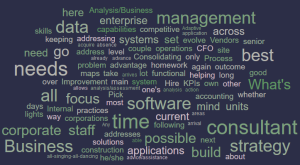What’s your corporate IT strategy?
Blog: KWKeirstead's Blog
 In the beginning, IT reported to the CFO because the main focus was on automating accounting functions, with, time permitting, helping other functional units to address their computing needs. None of the application systems were able to easily exchange data.
In the beginning, IT reported to the CFO because the main focus was on automating accounting functions, with, time permitting, helping other functional units to address their computing needs. None of the application systems were able to easily exchange data.
In manufacturing and construction, things progressed to where we saw “all-singing-all-dancing” materials management/workflow management applications, with data transfers to accounting.
The focus, at that time, shifted from addressing functional unit needs to addressing the needs of the enterprise and CIO’s started to report to the CEO, not the CFO.
The problem was strategic planners recognized the need for business analysis capabilities so they proceeded independently to set up Business Analysis/Business Process Improvement units. These units did not have the skills to evolve sophisticated mind maps capable of consolidating operational level data to KPIs, so they did most of their work using spreadsheets.
Meanwhile, most IT departments, with a prior focus on filling orders and keeping the lights on, not following the state-of-the-art of mind maps, did not have the time nor did they set about to acquire the skills to select enterprise solutions.
Consolidating the organization’s Business Analysis/Business Improvement capabilities with those of traditional IT became possible as corporations moved to “cloud” solutions, relieving IT of the burden of “keeping the lights on”.
Not all of these transitions went smoothly.
The combined talent pool of internal BA/BI/IT proved, in many cases, to be a poor substitute for a couple of days of senior management consultant on-site time. The competitive advantage of these folks is that they have seen multiple good/bad strategy development/implementation initiatives across different industry areas over several decades.
In the absence of expert advice/assistance, the tendency remains to go for one of the following three options.
Internal Build – the undertaking here is to build the next generation Ferrari in one’s garage. Not impossible, given that Bill Gates did it and Steve Jobs did it, why not us?
One-stop-shop – the idea here is to find a system that addresses one’s current needs to the extent possible and to then proceed to “customize” the system. Vendors love this option. The core problem of course is corporations really don’t want/need software that addresses current needs – they need software that can address unanticipated future needs.
Best of Breed Integration – this makes a lot of sense PROVIDING all of the applications you pick have a demonstrable capability of exporting their data and importing data from local and remote third party systems and applications. Any slip-ups here and you join the queue of customers pleading with vendors for customization.
So, what to do? . . . .
Hire a good consultant for a couple of days on-site.
Pick a reputable busy hands-on consultant who starts to get ready to leave from the time he/she arrives on site.
Their focus will be on analysis/assessment and on training your staff so that they can take over once the consultant has gone off-site. Do your homework in advance. Expect the consultant to also do a lot of homework such that on arrival he/she has a reasonable understanding of your business, your strategy and the current state of your operations.
Do not hire a consultant who borrows your watch to tell you what time it is.
What’s the best possible outcome?
The best possible outcome is likely to come out of generic software that allows operations level staff to build, own and manage their own processes.
They should only have to go to BA/IT for rule set construction and inter-connectivity by and between all of the systems you already have in place and do not particularly want to cast aside.
The usual great deficiency in organizations is inability to provide continuity across silos.
Adaptive Case Management software plus Business Process Management software go a long way to bridging the gap. Graphic Enterprise free-form search knowledge bases go a long way to helping corporate stakeholders to evolve strategies and track performance at KPIs.
Yes, my group promotes these solution sets and we also use them internally.
A good starting position is to recognize that every organization has “best practices” – it does not matter whether these exist only in the minds of staff or whether they are on paper, on-line or in-line. The main point is these are their “best practices” and will remain as such until these practices are replaced with improved practices.
The other thing they need to keep in mind is that their Job #1 is to build, maintain and enhance “competitive advantage”. This responsibility is shared across the Board, senior management and all staff. It’s all about “rowing in the same direction”.
What next? Read this blog post again and then again.
Then, take action.
Filed under: Adaptive Case Management, Business Process Management, Interoperability Tagged: #strategy, adaptive case management, business process analysis, operations management
![]()
Leave a Comment
You must be logged in to post a comment.







